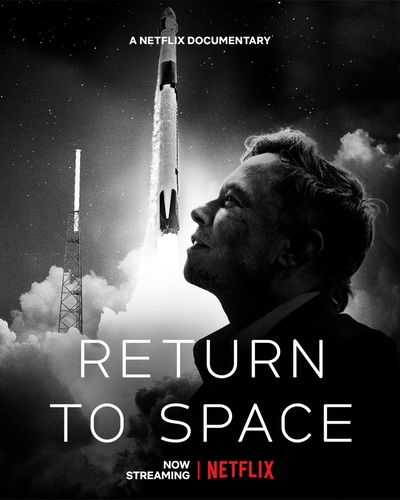 |
Review: Return to Space
by Jeff Foust
Monday, April 11, 2022
Return to Space
directed by Jimmy Chin and Elizabeth Chai Vasarhelyi
128 minutes, rated TV-MA
streaming on Netflix
Last Friday, a Falcon 9 lifted off from the Kennedy Space Center and placed into orbit a Crew Dragon spacecraft called Endeavour. The spacecraft docked to the International Space Station less than 24 hours later, delivering four private astronauts on the Ax-1 mission for Axiom Space. Shortly after Endeavour returns from its ten-day mission, another Crew Dragon, named Freedom, will launch on the Crew-4 mission for NASA, delivering American and European astronauts for a five-month stay.
| “He’s a human just like the rest of us,” Hurley saus of Musk. “We all have pluses and minuses.” |
Ax-1 and Crew-4 will be the sixth and seventh crewed missions launched by SpaceX in less than two years. That streak started with the launch of Demo-2 in May 2020, carrying NASA astronauts Bob Behnken and Doug Hurley on Endeavour to the ISS on the first crewed orbital flight from the US since the retirement of the Space Shuttle nearly nine years earlier. That flight is the subject of a new documentary, Return to Space, that premiered on Netflix last week.
The documentary, done in cooperation with NASA and SpaceX, takes viewers inside the preparations for flight, the launch itself, and through splashdown. That includes interviews with Behnken and Hurley, as well as SpaceX’s Elon Musk, Gwynne Shotwell, and Hans Koenigsmann, and then-NASA administrator Jim Bridenstine. Lori Garver, deputy administrator of NASA at the time the commercial crew program started, appears to discuss the origins of the program and the political opposition to it a decade ago.
There are no great revelations in the documentary, at least for those who followed the commercial crew program for years. The value is more in the views behind the scenes during preparations for the flight. Musk, in the launch control center during the first launch attempt that was scrubbed by weather, is frustrated and asks if the weather information that led to the scrub was up to date. In another, Bridenstine watches as NASA and SpaceX personnel rehearse NASA TV coverage for the launch, including what they would do if there was an anomaly on the pad (stay with a wide shot of the pad, a NASA official says, and not cutaway as a SpaceX person suggests.)
There is also some interesting archival footage, such as rarely seen views of the first three failed Falcon 1 launches, illustrating the company’s willingness to embrace failure. “The great thing about Elon is that he understands failure is part of the development,” Koenigsmann says.
| While Return to Space is billed as an inspiring documentary, it runs out of steam about two-thirds of the way through. |
Notably, the film shies away from any controversies beyond the origins of the commercial crew program itself. Musk’s infamous tweets, and his joint-smoking incident on Joe Rogan’s podcast, get brief mentions before the film moves on. (“He’s a human just like the rest of us,” says Hurley. “We all have pluses and minuses.”) While the launch turned into a political spectacle, with both President Trump and Vice President Pence attending and Trump giving a speech in the Vehicle Assembly Building after liftoff, it never comes up in the movie: we see only a fleeting glimpse of Pence and nothing of Trump.
While Return to Space is billed as an inspiring documentary, it runs out of steam about two-thirds of the way through. After the successful launch of Demo-2 and docking with the station, the film covers their two months on the ISS, including a spacewalk by Behnken and Chris Cassidy. But these activities are no different from those astronauts have performed on the station for two decades, and the drama building up to the launch has dissipated. Only when it’s time to return home, with the nail-biting in mission control as Musk and others await restoration of communications and deployment of the parachutes, does that drama return.
With a regular cadence of NASA and commercial Crew Dragon missions now, it’s easy to see then as commonplace, something that SpaceX officials reject. “This is not routine,” Benji Reed, SpaceX’s senior director for human spaceflight programs, said in a call with reporters after the launch of Ax-1 Friday, seeking to ward off any thoughts of complacency. The cadence of Crew Dragon missions is still far short of the shuttle at its peak, but it has restored a capability that was lost for nearly a decade. Return to Space celebrates that achievement.
Note: we are using a new commenting system, which may require you to create a new account.
No comments:
Post a Comment